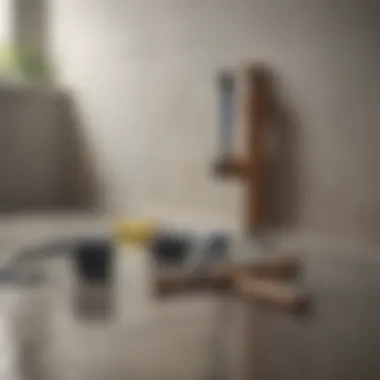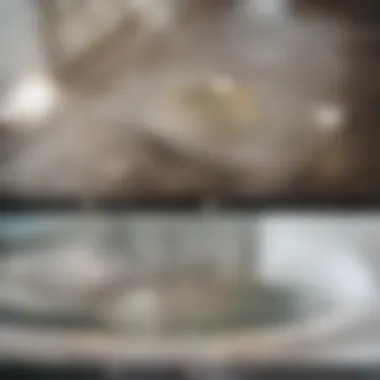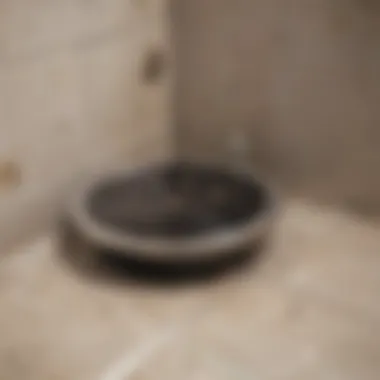Understanding Clogged Shower Drains: Causes & Solutions


Intro
Clogged shower drains present not only a practical inconvenience but also a signal of underlying plumbing issues. Many homeowners encounter this problem at some point. The reasons for clogs can range from hair and soap scum to more complex issues like tree roots invading pipes. This article serves as a comprehensive guide to understanding the causes, prevention techniques, and solutions for clogged shower drains. From simple DIY fixes to knowing when professional help is necessary, readers will gain valuable insights to help maintain their plumbing systems efficiently.
Understanding this issue begins with recognizing the factors that lead to clogs. Engaging in regular maintenance is equally critical for preventing future blockages. With this knowledge, readers can enhance their home's plumbing health, ultimately avoiding unnecessary repairs.
Prelude to Clogged Shower Drains
Understanding clogged shower drains is crucial for maintaining a functional home. A well-operating drainage system ensures not only hygiene but also prevents property damage from water accumulation. Homeowners often overlook the importance of proactive maintenance. However, neglecting your shower drains can lead to annoying clogs that disrupt daily routines.
Addressing clogged shower drains is about more than just clearing a blockage. It includes recognizing the factors that contribute to clogs, understanding how to prevent them, and knowing when to seek professional help. This guide will provide insights that can enhance the overall health of your plumbing system, ultimately leading to a more enjoyable and stress-free living environment.
What is a Clogged Shower Drain?
A clogged shower drain occurs when water cannot flow freely through the drain due to an obstruction. This obstruction can be caused by various elements, including hair, soap scum, and foreign objects. Most people experience slow drainage at first, which can feel like an annoyance. As time goes on, this can develop into a complete blockage. When this happens, water will not drain at all, which creates unsanitary conditions and dissatisfaction.
Clogs generally build over time. Each shower adds more hair and debris to the drain. It is important to recognize the early signs of clogs to avoid larger problems later.
The Importance of Drain Functionality
Proper drain functionality is essential for several reasons. First, it maintains hygiene within your bathroom. Stagnant water in a clogged drain can breed bacteria and mold, which can impact your health. Second, functional drains protect the structural integrity of your home. Continuous water accumulation can lead to water damage, affecting walls and floors.
Moreover, a well-functioning shower drain ensures convenience in daily activities. The last thing anyone wants is to stand in a pool of water while showering. Therefore, understanding and maintaining your shower drain can prevent significant issues down the line.
"Proactive care is more effective than reactive measures. Taking steps to maintain your drains can save you time and money."
Common Causes of Shower Drain Clogs
Understanding the common causes of shower drain clogs is crucial for any homeowner or renter wishing to maintain their plumbing systems effectively. When a shower drain becomes clogged, it not only disrupts the daily routine but can also lead to more significant issues if not addressed promptly.
Recognizing these causes helps minimize inconvenience and reduce potential repair costs. Knowing the root of the problem allows for targeted preventive measures, ensuring that drains function correctly over time. Moreover, awareness of what can obstruct drains will alert individuals to be proactive rather than reactive. Identifying these common causes is the first step toward maintaining clear and efficient showers.
Hair Accumulation
Hair is perhaps the most prevalent culprit in shower drain clogs. During a shower, strands of hair shed and often get tangled in the drain. Over time, this buildup can thicken, creating a barrier that hinders water flow. This accumulation can become particularly severe in households with multiple members, pets, or those with long hair.
To combat this, regular cleaning is essential. Simple actions like using a drain screen can catch hair before it enters the drain. For an effective immediate fix, a hand tool, known as a drain snake, can be helpful to pull out hair clumps that have settled deeper in the plumbing.
Soap Scum and Mineral Buildup
Soap scum occurs when soap reacts with minerals in the water. When combined with natural oils from the skin, it coats the inner walls of pipes. In areas with hard water, minerals such as calcium and magnesium can deposit themselves within the pipes alongside soap scum, leading to a gradual decrease in pipe diameter.
This buildup can impede water flow significantly and will require a mixture of regular cleaning and specific cleaning solutions designed to dissolve soap and mineral deposits. Utilizing vinegar or baking soda can help in breaking down these materials effectively.
Foreign Objects in the Drain
Accidental drops of small items into the drain can create unexpected blockages. Objects such as shampoo caps, small toys, or any debris that finds its way down can obstruct the flow, compounding existing issues.


To prevent this, individuals should be more mindful of what is near the drain while bathing. If an object does fall in, it is best to attempt to retrieve it immediately rather than let it settle deeper into the plumbing. Employing a drain snake or a simple grabber tool can assist in extracting these foreign bodies safely.
Improper Installation and Pipe Issues
Improper installation can lead to poor drainage performance. This includes pipes that are too small, lack proper slopes, or are misaligned. Such issues are not visible unless one inspects their plumbing. Old or damaged pipes can also be a source of clogs due to their deterioration over time.
In situations where plumbing has been recently upgraded or installed, it is wise to verify proper functionality soon after installation. If clogs continue despite preventive measures, consulting a plumbing professional may be necessary to assess installation quality and pipe integrity.
Signs of a Clogged Shower Drain
Recognizing the signs of a clogged shower drain is critical for effective plumbing maintenance. Early detection not only helps prevent extensive damage but also preserves the overall functionality of the drainage system. Ignoring these signs can lead to more severe issues that require costly repairs.
Slow Draining Water
One of the first signs you might notice is slow draining water. During a shower, you may observe that water takes longer than usual to disappear down the drain. This delay indicates that something is obstructing the flow. It can be a gradual process, often overlooked, giving a false sense of normalcy. However, if left unaddressed, this slow drainage can develop into a complete clog.
You can identify this issue easily. If water pools around your feet while showering, it is a clear indicator of a blocked drain. Regular attention to this situation is essential. Not only does this slow drainage affect your shower experience, but it can also lead to unsanitary conditions due to standing water.
Unpleasant Odors
Another obvious signal that should not be ignored is unpleasant odors coming from your shower drain. A strong, foul smell is often a sign of organic matter decomposition or stagnant water in the pipes. These odors can stem from hair, soap scum, and other debris that accumulate over time. If you begin to notice a lingering bad smell, it is a definite cue that your drain requires immediate attention.
These odors can not only be annoying but also pose health risks. If bacteria proliferate in stagnant water, it may lead to unhygienic conditions in your bathroom. Addressing this sign promptly aids in maintaining not just a pleasant-smelling environment but also a healthy living space.
Gurgling Sounds
Gurgling sounds are often the final warning sign that indicates a potential clog. If you hear unusual noises emanating from your shower drain while the water is draining, it may indicate trapped air attempting to escape through an obstruction. These sounds can disrupt the otherwise tranquil experience of showering.
Gurgling often suggests that the blockage is not far from the surface. Ignoring these noises could result in more severe plumbing issues, such as backup or flooding. Quick action is vital when these sounds are present.
Remember: Act quickly upon noticing these signs to maintain a functional and hygienic shower environment.
In summary, recognizing the signs of a clogged shower drain—such as slow draining water, unpleasant odors, and gurgling sounds—can save you time and money in the long run. Being proactive with your plumbing will help ensure a more pleasant experience in your bathing space.
DIY Techniques for Unclogging Shower Drains
Unclogging shower drains can be frustrating, yet many common clogs can be resolved without professional help. This section focuses on practical DIY techniques for tackling these issues. These methods are often cost-effective and can save time. Familiarizing yourself with these techniques helps maintain your drain's efficiency.
Using a Plunger
The plunger is a staple in plumbing solutions, and for good reason. Its effectiveness comes from using physical force to dislodge blockages. Here’s how to use a plunger for a clogged shower drain:
- Preparation: Start by removing any standing water in the shower. This allows the plunger to create better suction.
- Positioning: Place the plunger over the drain, ensuring there is a good seal. It is important to cover the overflow drain, if present, with a wet cloth or your hand. This helps to enhance the pressure.
- Pumping: Begin to pump the plunger up and down vigorously for 15 to 20 seconds. Do not lift it from the drain, as this can break the suction.
- Testing: After several pumps, check to see if the water drains away. If still clogged, repeat the action a few more times.
This method is simple yet can be effective in many situations.
Employing Baking Soda and Vinegar


A mixture of baking soda and vinegar can serve as an effective natural solution to unclog drains. This technique is both safe for the environment and can break down certain types of build-up:
- Apply Baking Soda: Pour about half a cup of baking soda directly into the clogged drain.
- Add Vinegar: Follow the baking soda with half a cup of vinegar. The chemical reaction will produce fizzing, which helps dislodge the clog.
- Wait: Allow the mixture to sit for approximately 30 minutes. During this time, the solution works on the debris.
- Flush with Hot Water: Finally, flush the drain with boiling water to help clear out any remaining particles.
This method not only reduces clogs but also minimizes unpleasant odors in the drain.
Utilizing a Drain Snake
If the clog persists, a drain snake can be a robust solution. This tool is effective in reaching deeper blockages that other methods cannot touch. Here’s how to use it effectively:
- Insert the Snake: Carefully insert the tip of the drain snake into the shower drain, feeding it gently until you feel resistance.
- Crank the Handle: Turn the handle of the snake clockwise while pushing it into the drain. This helps to grasp any debris that is causing the clog.
- Retrieve the Snake: Once you feel the blockage loosen, pull the snake out carefully, bringing the debris with it.
- Flush the Drain: To finalize, use hot water to clear any remaining debris.
Utilizing a drain snake may require some practice but can be very effective for more stubborn clogs.
Hot Water Flush
Using hot water is one of the simplest methods. This technique can help dissolve and wash away grease and soap scum accumulation, which can often be the core of the problem:
- Boiling Water: Heat up a kettle or pot of water until it is boiling but be careful with handling.
- Pour Gradually: Slowly pour the hot water into the drain in stages. Allow time between pours to see if it drains effectively.
- Repeat as Necessary: If the drain does not clear immediately, repeat the process until you notice improvement.
Remember, always consider the material of your plumbing pipes. Very hot water may not be suitable for some older pipes, as it can cause cracks or further damage.
In summary, these DIY methods can often resolve clogged shower drains effectively. They provide a range of options from physical force to chemical reactions, giving homeowners several avenues to pursue.
By taking the time to understand the requirements and methods of unclogging, homeowners can empower themselves to maintain their plumbing effectively.
Professional Solutions for Severe Clogs
Addressing severe clogs in shower drains is a critical aspect of maintaining effective plumbing. While many clogs might be resolved with DIY techniques, sometimes professional intervention becomes necessary. Recognizing when to engage a professional can save time, money, and prevent further complications. Professional solutions address persistent issues that are beyond the scope of standard maintenance.
When to Call a Plumber
Understanding the right moment to call a plumber is vital. If you notice the following signs, you should consider seeking professional help:
- Repeated Clogs: If the shower drain clogs frequently, it indicates an underlying issue that needs expert diagnosis.
- Slow Draining: A consistently slow drain after trying DIY methods may signal a more serious blockage deep within the pipes.
- Unpleasant Smells: Bad odors emanating from the drain could be a sign of serious buildup or decay within the plumbing that requires professional attention.
Ignoring these signals could result in more significant plumbing problems.
Hydro Jetting Techniques
Hydro jetting is a professional method used to clear severe clogs in shower drains. This technique utilizes high-pressure water jets to remove stubborn debris and buildup from the pipes. Here are the benefits of hydro jetting:
- Thorough Cleaning: Unlike traditional snaking methods, hydro jetting cleans the walls of pipes, removing all residue.
- Preventive Care: Regular hydro jetting can prevent future clogs by ensuring that pipes remain clear of buildup.
- Non-Invasive: This method does not require digging up landscaping or damaging walls, making it an efficient solution.
Hydro jetting is often recommended when traditional methods fail, providing a long-term solution to stubborn plumbing issues.
Drain Inspection Services


Drain inspection services are essential for diagnosing persistent problems in shower drains. Using advanced technology such as video cameras, plumbers can assess the condition of the drainage system.
The benefits of drain inspection include:
- Accurate Diagnosis: Plumbers can identify the exact location and nature of the blockage, ensuring targeted solutions.
- Identifying Damage: This service helps in discovering any structural issues in the pipes, such as cracks or misalignments, which can worsen over time.
- Preemptive Measures: A thorough examination may reveal potential issues before they escalate, saving homeowners time and costs in the long run.
Employing professional solutions such as hydro jetting and drain inspections can significantly enhance the functionality of your plumbing system. Real estate enthusiasts, travel lovers, and interior design aficionados alike will benefit from understanding these crucial measures in maintaining their home’s infrastructure.
Preventative Measures to Avoid Clogs
Preventative measures are essential in maintaining the functionality of shower drains. By taking proactive steps, homeowners can significantly reduce the likelihood of clogs, which can lead to inconvenient and costly repairs. This section explores various strategies that not only help prevent blockages but also extend the lifespan of plumbing systems.
Regular Maintenance Routines
Establishing a routine maintenance schedule is crucial for keeping shower drains clear. Regularly cleaning the drain is one of the simplest yet most effective ways to prevent buildup.
- Monthly Inspections: At least once a month, inspect your shower drain for any visible debris or hair accumulation. This can be a straightforward task, requiring minimal tools, such as a pair of gloves and a small trash bag.
- Bi-annual Deep Cleaning: Twice a year, conduct a more thorough cleaning. Remove drain covers and use a mixture of hot water and vinegar to flush the pipes. The vinegar helps in breaking down mineral deposits and soap scum.
- Track Usage: Keep a record of when clogs occur to identify patterns or specific times when usage spikes, which may contribute to clogs.
By taking these steps, homeowners not only maintain the flow of water but also foster an overall healthier plumbing environment.
Use of Drain Screens
Installing drain screens is a straightforward yet effective preventative measure. These simple devices serve as a barrier, capturing hair and other debris before they can enter the plumbing system.
- Types of Screens: There are different types of drain screens available in the market. Some fit directly over the drain, while others are integrated into the drain structure itself.
- Easy Maintenance: Drain screens should be cleaned regularly—ideally once a week. Removing hair and debris collected on the screens can greatly reduce the volume of waste entering your drainage system.
- Affordability: Considering their low cost and ease of installation, drain screens provide a strong return on investment. This small effort can save significant costs associated with major plumbing repairs in the future.
Educating Household Members
Another essential aspect of preventing shower drain clogs is ensuring that all household members understand proper practices for drainage use. Education plays a key role in promoting responsible usage.
- Communicate The Problem: Discuss the importance of keeping drains clean. Explain how hair, soap, and other materials contribute to clogs.
- Establish Guidelines: Set guidelines for what can and cannot be rinsed down the shower drain. For example, encourage members to dispose of hair in the trash instead of letting it wash down the drain.
- Engage Everyone: Make drain maintenance a collaborative effort. Regular reminders can foster a sense of community responsibility for maintaining a functional home.
Remember: A clear understanding among all household members can significantly decrease the occurrence of clogs, making it a key component of drain care.
Adopting these preventative measures contributes to a more efficient plumbing system. With awareness and proactive strategies, it is possible to maintain a hassle-free bathroom experience.
The End
The conclusion serves as a vital component in wrapping up the discussion around clogged shower drains. It consolidates knowledge and encourages proactive behaviors among readers. The significance of summarizing key points cannot be understated. In a world where plumbing issues can lead to costly repairs, understanding the underlying causes of clogs can save both time and money. The readers are reminded of the importance of regular maintenance routines, the effectiveness of DIY techniques, and knowing when to seek professional help.
Summary of Key Points
In the previous sections, we explored numerous aspects concerning shower drains. Key points include:
- Identifying causes: Understanding how hair, soap scum, foreign objects, and improper installations contribute to blockages.
- Recognizing signs: Learning to identify the early indicators of a clog, such as slow drainage and gurgling sounds.
- DIY techniques: Simple methods like using a plunger, baking soda and vinegar, or a drain snake offer initial solutions.
- Professional assistance: Knowing when issues exceed one’s skill set and require expert intervention is crucial.
- Preventative measures: Incorporating drain screens and education among household members reduce the likelihood of future clogs.
Final Thoughts on Drain Care
Ultimately, caring for your shower drain means developing a mindset focused on maintenance and prevention. One should not wait for visible signs of trouble before taking action. Implement simple routines regularly. Educate family members about proper waste disposal practices to sustain functionality.
"An ounce of prevention is worth a pound of cure."
As you implement these practices, remember that a proactive approach will not only promote a smooth drainage experience but will also enhance the longevity of your plumbing system. Being informed and diligent in drain care ensures that minor issues do not escalate, leading to serious inconveniences.















